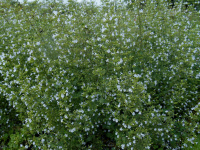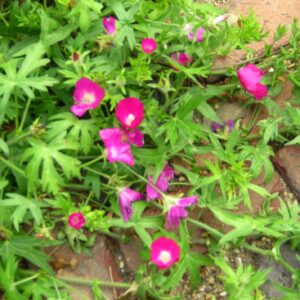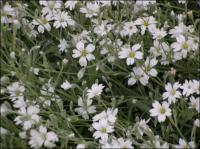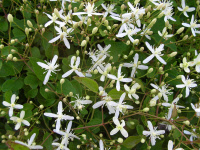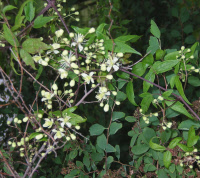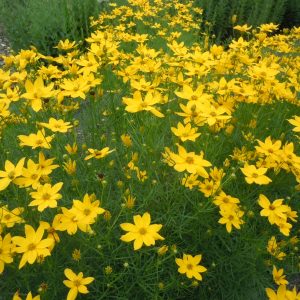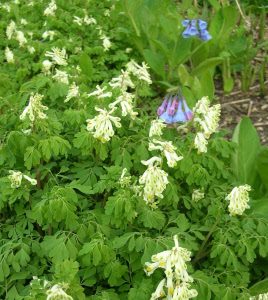Drought, Xeric & Dry Soil Plants
Showing 25–32 of 132 results
-
Calamintha nepeta ssp. nepeta syn. Clinopodium nepeta ssp. nepeta Lesser calamint Z 4-9
Profuse violet blooms on mint-scented, gray-green foliage gives frosty image, June-October
Profuse violet blooms on mint-scented, gray-green foliage gives frosty image, June-October
Size: 18-24” x 8-12”
Native: Europe and Mediterranean
Wildlife Value: attracts bees, butterflies and hummingbirdsThis subspecies 1st described by Linnaeus in 1753. Genus name comes from Greek kalos meaning beautiful and minthe meaning mint. It is not, however, a mint and is not invasive.
-
Callirhoe involucrata Wine cups, Prairie poppy mallow
Magenta-purple upfacing cups, June - October
Magenta-purple upfacing cups, June – October, non-stop. Wonderful for rock gardens or as a ground cover.
Size: 6" x 12"
Care: Full sun in well-drained soil. Drought tolerant
Native: Missouri to TexasAlthough an American prairie native, Callirhoe is named for the daughter of the Greek river god. Teton Dakota burned its dried root for smoke to cure the common cold and aches and pains. First collected by Thomas Nuttall in 1834. Ferry’s 1876 catalog described it as having “a trailing habit, of great beauty.” William Robinson extolled Prairie mallow as “excellent for the rock garden, bearing a continuous crop of showy blossoms from early summer till late in autumn.”
-
Cerastium biebersteinii Mouse ear Z 4-7
White felt-like foliage, covered with white flowers
White felt-like foliage, covered with white flowers in spring. Makes a wonderful groundcover.
Size: 6" x spreading
Care: Sun in well-drained soil
Native: TauriaCerastium is from the Greek keras meaning horn because of the shape of the seed capsule. Six inch tall, spreading, small chalky-velvet leaves. Rarely offered but should be. Used as a groundcover for its frosted, felt-like foliage under tropical plants in Victorian gardens. American gardens since 1860.
-
Clematis ternifolia Sweet Autumn clematis Z 4-8
Fragrant, small white blossoms smother this vigorous vine
Fragrant, small white blossoms smother this vigorous vine in September and October.
Can not ship to: Alabama, Delaware, Florida, Georgia, Maryland, Nebraska, New York, North Carolina, South Carolina, Tennessee and Virginia.
Size: 15-20’ x 6-10’
Care: Sun moist well-drained soil mulched. Flowers on current year’s wood. Cut back in early spring to 6-8” above the soil.
Native: JapanThe genus Clematis was named by Dioscordes, physician in Nero’s army, from “klema” meaning climbing plant. In 1877 seeds of this vine sent from Russia to the Arnold Arboretum in Boston, then distributed to nurseries throughout America.
-
Clematis virginiana Virgin’s bower, Devil’s darning needles Z 4-8
July-September star-like white blossoms
OUT OF STOCK
July-September star-like white blossoms cover this vine – good for clambering up small trees.
Size: 12-20’ x 4’
Care: Sun to shade moist well-drained soil. Flowers on new stems so cut back in late winter or early spring to 6-8” above the ground.
Native: Nova Scotia to Georgia and as far west as Kansas, Wisconsin nativeThe genus Clematis was named by Dioscordes, physician in Nero’s army, from “klema” meaning climbing plant. One of 1st No. American plants sent to Europe – grew in Tradescant the Elder’s South Lambeth nursery in 1634. Grown by Jefferson at Monticello in 1807. Described by Breck in his 1851 book The Flower Garden: “The flowers are white borne upon cymes, and make a handsome appearance.” Cherokee mixed this plant with milkweed to remedy backaches. A root extract cured stomach aches, nervous conditions and kidney ailments. For the Iroquois powdered root fixed venereal disease sores and an extract of the stem brought on strange dreams. Pressed specimen in Emily Dickinson’s herbarium.
-
Coreopsis verticillata Thread leafed tickseed Z 4-9
All summer into fall, free-blooming non-stop - yolk yellow daisies of 8 narrow spoon-shaped petals with a color matching center each atop a wiry stem. Cut back half-way to promote reblooming in fall.
All summer into fall, free-blooming non-stop – yolk yellow daisies of 8 narrow spoon-shaped petals with a color matching center each atop a wiry stem. Cut back half-way to promote reblooming in fall.
Size: 24" x 18" spreading
Care: Sun to part shade well-drained to moist well-drained soil, drought tolerant
Native: S.E. U.S.
Wildlife Value: attracts butterflies, Deer resistantExported from its native America to England in 1759. Used to dye cloth red.
-
Corydalis lutea syn. Pseudofumaria lutea Yellow fumitory, Z 4-8
Clumps of canary yellow narrow tube-shaped flowers with flared ends bloom over mounds of ferny foliage from late spring – fall. Longest blooming shade flower
Clumps of canary yellow narrow tube-shaped flowers with flared ends bloom over mounds of ferny foliage from late spring – fall. Longest blooming shade flower
Size: 9-15" x 18"
Care: part shade to shade in moist well-drained to well-drained soil
Native: Throughout EuropeCorydalis is Greek for “lark” korydalos, referring to the shape of flower, a lark’s spur. Lutea means “yellow.” According to 16th century herbalist Culpepper, “Saturn owns the herb” so Corydalis lutea cured Saturn’s diseases of the liver, spleen, leprosy, scabs, itches, cholera, salty blood, jaundice, melancholy, plague, pestilence and red eyes. Greek physician Dioscordes authored 5-volume De Materia Medica writing that this “hinders fresh springing of hairs on the eye lids.”
-
Corydalis ochroleuca syn. Pseudofumaria alba Z 4-8
Clumps of crem white with a touch of yellow, narrow, tube-shaped flowers with flared ends bloom over mounds of ferny foliage from late spring – fall. One of longest blooming flowers for shade.
OUT OF STOCK
Clumps of cream white with a touch of yellow, narrow, tube-shaped flowers with flared ends bloom over mounds of ferny foliage from late spring – fall. One of longest blooming flowers for shade.
Size: 6-12” x 12”
Care: Shade to part shade in well-drained soil
Native: BalkansCorydalis is Greek for “lark” korydalos, referring to the shape of flower resembling a lark’s spur. This species published in 1831. Gertrude Jekyll (1848-1931) planted Corydalis ochroleuca as a “wide carpet” under peonies in her spring garden at her home, Munstead Wood.

